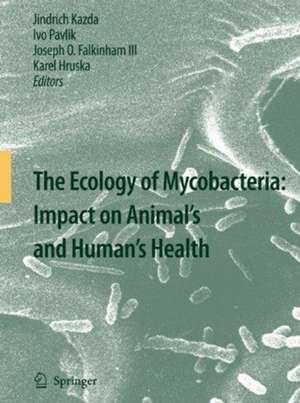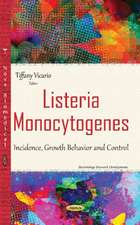The Ecology of Mycobacteria: Impact on Animal's and Human's Health
Autor Jindrich Kazda, Ivo Pavlik, Joseph O. Falkinham III, Karel Hruskaen Limba Engleză Paperback – 23 aug 2016
| Toate formatele și edițiile | Preț | Express |
|---|---|---|
| Paperback (1) | 1071.00 lei 38-44 zile | |
| SPRINGER NETHERLANDS – 23 aug 2016 | 1071.00 lei 38-44 zile | |
| Hardback (1) | 1096.15 lei 38-44 zile | |
| SPRINGER NETHERLANDS – 9 iul 2009 | 1096.15 lei 38-44 zile |
Preț: 1071.00 lei
Preț vechi: 1409.21 lei
-24% Nou
Puncte Express: 1607
Preț estimativ în valută:
204.96€ • 212.77$ • 170.90£
204.96€ • 212.77$ • 170.90£
Carte tipărită la comandă
Livrare economică 18-24 martie
Preluare comenzi: 021 569.72.76
Specificații
ISBN-13: 9789401777100
ISBN-10: 9401777101
Pagini: 522
Ilustrații: XVIII, 522 p.
Dimensiuni: 192 x 260 mm
Ediția:Softcover reprint of the original 1st ed. 2009
Editura: SPRINGER NETHERLANDS
Colecția Springer
Locul publicării:Dordrecht, Netherlands
ISBN-10: 9401777101
Pagini: 522
Ilustrații: XVIII, 522 p.
Dimensiuni: 192 x 260 mm
Ediția:Softcover reprint of the original 1st ed. 2009
Editura: SPRINGER NETHERLANDS
Colecția Springer
Locul publicării:Dordrecht, Netherlands
Cuprins
The Chronology of Mycobacteria and the Development of Mycobacterial Ecology.- Obligate Pathogenic Mycobacteria.- Potentially Pathogenic Mycobacteria.- Physiological Ecology of Environmental Saprophytic and Potentially Pathogenic Mycobacteria.- Environments Providing Favourable Conditions for the Multiplication and Transmission of Mycobacteria.- The Occurrence of Pathogenic and Potentially Pathogenic Mycobacteria in Animals and the Role of the Environment in the Spread of Infection.- Transmission of Mycobacteria from the Environment to Susceptible Hosts.- Biological Role of Mycobacteria in the Environment.- Key Research Issues.- Photographs.
Recenzii
From the reviews:“If you are by any means interested in the microbial ecology of mycobacteria … this book is your choice. … The pictures are of high technical standard and imminently supply the body of the text by references. … addresses a wide range of scientists and others who are engaged in epidemiology, epizootology, immunology, environmental ecology, and animal husbandry. It presents the state of the art of the ecology of mycobacteria, a virtual gold mine of the subject. Do not miss it.” (Niels Skovgaard, International Journal of Food Microbiology, Vol. 136, 2010)“The primary focus is the ecology of mycobacteria species in human and animal diseases, including mycobacteria interactions and roles in the environment. … The editors have included examples, graphics, bibliographies, and references to the illustrations … to explain the concepts and ideas discussed. The information included in this work is recent and relevant and will be useful to readers wishing to gain an understanding of general mycobacterial ecology. Summing Up: Recommended. Lower-division undergraduates through graduate students, general audiences.” (P. M. Watt, Choice, Vol. 47 (7), March, 2010)
Textul de pe ultima copertă
The Ecology of Mycobacteria principally emphasizes the ecological characteristics of the environmental mycobacteria. It is now well understood that the incidence and prevalence of potentially pathogenic mycobacteria is increasing in humans and animals. Further, proof that mycobacteria are normal inhabitants of drinking water distribution systems and household water systems, indicates that humans and animals are surrounded by mycobacteria and thus at risk. It is anticipated that the emphasis on ecology and routes of infection will result in a text of widespread use for clinicians and for research scientists in medicine, academia, and industry. In addition to identifying habitats and thereby sources of mycobacteria infecting humans and animals, the text identifies those mycobacterial characteristics that determine its range of habitats. Additionally, the text comments critically on the available methods to identify those protocols with values in mycobacterial research. In that manner, although there are no chapters specifically devoted to methods, superior methods for mycobacteria will be identified.
A new text is needed for the mycobacteria because the prevalence of disease caused by the environmental potentially pathogenic mycobacteria is increasing. This increase is due to a number of factors. Host factors contribute to an increasing population of individuals more susceptible to mycobacterial infection. For example, the aging of the human population and the increasing frequency of immunosuppressed individuals as a result of infection (e.g. HIV), chemotherapy, and transplant-associated immunosuppression are all factors leading to increased susceptibility of infection with environment derived mycobacteria. Moreover, the role of mycobacteria as triggers in different autoimmune diseases is more and more evident. It is highly probable that peptidoglycans, lipoglycans, lipoproteins, heat shock proteins and some other structures from the mycobacterial cell wall,participate in different pathways of non-specific inflammatory reactions in humans, namely those with a specific genetic disposition. In such events mycobacteria in drinking water and food, even devitalized, have to be considered as a public health risk.
Second, human-engineered systems such as drinking water distribution systems are creating a habitat for the selection and proliferation of the potentially pathogenic mycobacteria. In as much as drinking water brings together overlapping habitats of both mycobacteria and humans and animals, a review of mycobacterial ecology is timely. The ecology of mycobacteria helps to understand the circulation of mycobacteria into the respective disciplines such as epidemiology, epizootology, immunology, environmental ecology, animal husbandry and environment conservation.
A new text is needed for the mycobacteria because the prevalence of disease caused by the environmental potentially pathogenic mycobacteria is increasing. This increase is due to a number of factors. Host factors contribute to an increasing population of individuals more susceptible to mycobacterial infection. For example, the aging of the human population and the increasing frequency of immunosuppressed individuals as a result of infection (e.g. HIV), chemotherapy, and transplant-associated immunosuppression are all factors leading to increased susceptibility of infection with environment derived mycobacteria. Moreover, the role of mycobacteria as triggers in different autoimmune diseases is more and more evident. It is highly probable that peptidoglycans, lipoglycans, lipoproteins, heat shock proteins and some other structures from the mycobacterial cell wall,participate in different pathways of non-specific inflammatory reactions in humans, namely those with a specific genetic disposition. In such events mycobacteria in drinking water and food, even devitalized, have to be considered as a public health risk.
Second, human-engineered systems such as drinking water distribution systems are creating a habitat for the selection and proliferation of the potentially pathogenic mycobacteria. In as much as drinking water brings together overlapping habitats of both mycobacteria and humans and animals, a review of mycobacterial ecology is timely. The ecology of mycobacteria helps to understand the circulation of mycobacteria into the respective disciplines such as epidemiology, epizootology, immunology, environmental ecology, animal husbandry and environment conservation.
Caracteristici
All current information on the Ecology of Mycobacteria in one volume Presentation of exhaustive discussion of routes of infection, thus providing guidance to prevention of infection The physiology and genetics relating to the ecology of mycobacteria thus allowing the prediction of the presence of mycobacteria in novel habitats, particularly human engineered habitats








